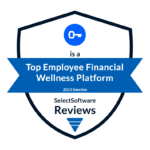The COVID-19 pandemic caused widespread global economic chaos, complete with runs on toilet paper and headlines like “2020 Was the Worst Year for Economic Growth Since World War II.”
Despite the dire circumstances, many households (on average) were doing better by a variety of financial measures.
But benefits leaders need to be careful not to draw the wrong conclusions from this phenomenon, which has since been dubbed the “pandemic paradox.”
The fact is, temporary trends during this time masked longer-term financial health needs. Sadly, the pandemic paradox was primarily caused by two temporary factors:
- Restrictions on activities that drive spending
- Extraordinary government support
When we look more carefully at the data, we see the positive trends eroding. As the tide of artificially high increases in how much Americans were saving goes out, we’re able to see the more urgent underlying truth: We are a nation living on the financial edge.
The pandemic paradox artificially propped up workers’ financial health
Workers really did do better in many ways after the pandemic. But we use the word “artificial” because these were not long-term changes.
First, there was the phenomenon mostly affecting those with higher incomes: Artificial constraints on spending. Think things like travel and live entertainment. This was caused by a mix of factors, such as government restrictions and personal caution.
Second, there was the phenomenon that most drove financial health for those who are most financially stressed: Government support. The U.S. government mounted an extraordinary response to prop up households, from stimulus checks to supersized unemployment benefits.
This support was not limited to the flashy increases in cash transfers via stimulus checks and tax credits. Government healthcare eligibility rules were relaxed. Evictions were prevented by law. Federal student loan payments and collections were paused for years.
The combination of these one-time factors created surprising changes. The national personal savings rate skyrocketed, peaking in 2020 and achieving a second boom in early 2021. It was not just savings; credit scores also went up.
The tide has gone out
If you’re working off of old data about your employees, you may miss the big story of 2023 for Americans’ finances: The tide has changed.
Pandemic-era restrictions around travel and activities involving social distancing have ended. And the crisis-related government supports are fading into memory as well. Key expansions some policymakers sought to continue are dead for now, like the expanded Child Tax Credit. Federal student loan payments will resume in October. And with the debt ceiling deal signed into law creating caps on discretionary spending, increasing generosity to struggling households will have to wait for now.
And so the key indicators of household financial health have gone down. This, despite the continued strength of the labor market, but with help from macroeconomic forces like inflation.
The numbers speak to worsening conditions for those at the bottom of the financial health spectrum. The personal savings rate: Down to its lowest rate since the Great Recession. Credit card debt: Growing sharply. Credit card delinquencies: On the rise. The difficulty of obtaining needed credit, also on the rise.
Improving employee financial health requires being aware of what’s happening now
As you shape your benefits strategy, it’s important to be aware of the actual state of employee financial health, despite what some pandemic-era data might indicate. The vast majority of your employees are living paycheck to paycheck, despite how much income they earn.
We at Brightside created a new category in employee benefits called Financial Care, which is the only model built specifically to support all employees, including the 70% living paycheck to paycheck.





